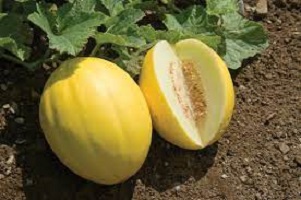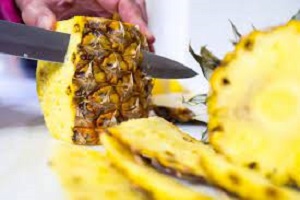Canary melon Amazing Facts and Health Benefits
Canary melon Amazing Facts and Health Benefits. Please Watch >>>>
Canary melon is a fruit that resembles honeydew, yellow melon, and cantaloupe and is native to Persia.
The canary melon, also known as Spanish melon or Juan Canary, is sweet like cantaloupe and goes well with citrus or ginger flavors. It also makes a delicious cold soup or beverage.
The golden canary melon, like other melons, is a healthy addition to your diet and offers a lot of benefits.
This melon not only helps you control your calorie intake, but it’s also an excellent source of nutrients that aid in disease prevention.
Related >>>>
- 10 Important Facts about Golden Melon – Benefits & Risk
- Health Benefits of Golden Melon Fruit & Seed
- Honeydew Melon Nutrition Facts and Amazing Health Benefits
What is a Canary Melon?
The canary melon is a sizable, bright-yellow, oval-shaped melon with a smooth surface and an inside flesh that ranges from light green to white.
The melon reaches peak ripeness when its hard skin turns bright yellow, becomes corrugated in appearance, and feels slightly waxy and smooth, and the flesh turns a delicate ivory color.
A little sweeter than a honeydew melon, this melon has a distinctly sweet flavor. The flesh is delicate and appealing to sight, resembling the flesh of a pear.
The fruit is known by a number of names, including sweet melon, yellow melon, Juan canary, Spanish melon, and others.
There is a very good probability that if you are walking the streets of a city in Nigeria at this season, you may come across a hawker selling canary melons or see a fruit stand with this golden-yellow fruit that isn’t a grape.
However, despite your encounter with the yellow melon, you might still be less informed than I was a while ago and ask what the advantages of this golden ball are and how it differs from other melons.
Unexpectedly, you might even refer to it by a different name. Whatever group you belong to, please continue reading.
The ten incredible facts about canary melon that you should be aware of are listed below.
Because the rind of these golden melons is the same bright yellow color as the canary bird, the melon received its name from this bird.
10 Canary Melon Amazing Facts
- Canary melon fruits get their name from the canary bird because the rind is the same bright yellow color as the bird.
- When canary melons are fully mature, they release a delicate, tropical scent with hints of pineapple and banana. The melons have a particularly mild, sweet, and tangy flavor due to their 13.9 Brix sugar level, which is a measure of the amount of sugar in the flesh.
- Yellow melons, botanically classified as Cucumis melo, are a sweet variation of the muskmelon that is a member of the Cucurbitaceae family.
- The melons go by a number of names, including Spanish Melon, San Juan Canary Melon, Juan Canary, Jaune des Canaries, Amarillo Melon, and Spanish Melon.
- Canary melons are mostly grown for fresh eating and lack the typical musky aroma of muskmelons.
- The canary melon has a lengthy shelf-life after being removed from the vine because of its firm rind, which enables long-term storage.
- It hydrates the body very well because it is roughly 90% water.
- Canary melon fruit can also be dried and used as a convenient, anytime snack.
- Seeds can be crushed into seed oil, dried, or roasted. Thus, every part can be consumed. The seeds are also planted in order to grow the fruit.
- Vitamin C, pantothenic acid, calcium, zinc, vitamin B6, fiber, magnesium, iron, potassium, vitamin A, and omega-3 and 6 are all present in yellow melon fruits.
Taste.
Yellow canary melons, unlike other melons, have flesh that is edible and succulent. They are also known to be extremely sweet and taste more like honeydew melon.
In contrast, watermelon is controversial because some people think the flesh can be harmful to the body while others claim it has some nutritional benefits.
Canary Melon Calories – Nutritional Value
One cup of canary melon only has 80 calories in it as a serving size. For such a delicious and healthy snack, this portion size is quite little.
Canary melon contains vitamin C, pantothenic acid, calcium, zinc, vitamin B6, fiber, magnesium, iron, potassium, vitamin A and omega-3 & 6.
Health Benefits of Canary Melon
The canary melon, like other melons, is a beneficial addition to your diet and offers a lot of advantages. This melon not only helps you control your calorie intake, but it’s also an excellent source of nutrients that aid in illness prevention.
Saves You Calories While Filling You Up
According to the Centers for Disease Control and Prevention, people typically consume the same quantity of food each day, calorie content or not.
Eat more foods with low energy densities, such as canary melons, if you’re having trouble reducing or maintaining your weight.
The canary melon has 25 calories in a portion of ½ cup, and with only 0.3 calories per gram, it is a low-energy-dense item that you can eat a lot of without overindulging in calories.
Maintains Regularity
Canary melons have 10 grams of fiber per ½ cup serving, making them a superior source of fiber. In addition to easing constipation, increasing your intake of fiber can also lessen your risk of developing heart disease, diabetes, obesity, and high blood pressure.
Safeguards against free radicals
These melons are rich in vitamin C and provide 50% of the RDA. Antioxidant vitamin C shields your body from cell-damaging free radicals.
These drugs have been related to aging and may make you more vulnerable to cancer and heart disease.
They develop as a result of food digestion or exposure to contaminants from the environment, such as radiation or cigarette smoke.
Consuming a fruit salad with canary melon in it may prevent chronic illness and delay the onset of aging.
Promotes Clear Vision
This melon is a good source of vitamin C and also contains a lot of vitamin A. A serving of ½ cup provides 50% of the recommended daily intake of vitamin A.
Vitamin A consumption must be sufficient for good eye health. Rhodopsin, the protein in the eye that absorbs light, is a crucial component of vitamin A.
It also supports the proper functioning of the cornea.
The Bottom Line
Although the canary melon hasn’t gained the same notoriety and acclaim as its melon counterparts, you should still think about including it in your diet for more reasons than just a novel, refreshing flavor.
Fruit melon contains a lot of carotenes, which can be consumed to lessen the risk of heart attack and prevent cancers like lung cancer.
The seeds of cancer that attack the body can be stopped and killed by melon fruit. So eating melon is a great way to prevent cancer.
The melon fruit is beneficial for keeping the skin healthy. Your skin will look gorgeous because of its collagen content.
All connective tissues, such as the skin, include protein molecules that have an impact on the integrity of the cell structure.
Additionally, collagen aids in wound healing and skin elasticity maintenance.
Q&A
Can you eat the skin on a canary melon? Which melon is the healthiest?
The lowest number of calories are found in watermelon, which only has 46 calories per cup.
On the other hand, it has a healthy quantity of potassium, vitamin A, and the antioxidant lycopene, which has been associated with a lower risk of cancer, heart disease, and age-related eye issues.
Is canary melon high in sugar?
The melons have a particularly mild, sweet, and tangy flavor due to their 13.9 Brix sugar level, which is a measure of the amount of sugar in the flesh.
Can I eat canary melon seeds?
You do not eat the seeds of most melons, including the Korean melon. If you’d like, you can use the spoon to scoop out the meat right away.
Alternatively, you can slice it lengthwise several times to create manageable portions.
Why is it called a canary melon?
The melon gets its name from the vivid yellow rind that is reminiscent of the bird that has the same name.
The cantaloupe-like cantaloupe has a considerably rougher, less smooth, and more honeydew-like brilliant rind.
Corrugation is the term for the fruit’s rind’s development of a little wrinkled appearance as it ripens.
Can you eat canary melon raw?
Fresh canary melon has a flavor similar to that of cantaloupe and Asian pears with soft, luscious flesh.
The beautiful brilliant yellow fruit has a smooth peel that becomes slightly wrinkled as it ripens.
These unique melons can be consumed in recipes like salads, smoothies, juice, shakes, and sorbets as well as raw in slices.
A canary melon contains how many calories?
With only 0.3 calories per gram and 25 calories per ½ cup portion, this melon is a low-energy-dense item that you can eat a lot of without consuming too many calories.
What is the number 1 healthiest fruit? Top 10 healthiest fruits
- A low-calorie snack, high in both soluble and insoluble fiber
- The most nutritious fruit in the world
- Banana
- Citrus fruits
- Coconut
- Grapes
- Papaya
- Pineapple
Are melons anti-inflammatory?
Compounds called phytonutrients in cantaloupes give it anti-inflammatory properties and it’s a good part of a healthy diet.
How much potassium is in a canary melon fruit?
- Whole Melons
| Nutrition Facts | |
| How much potassium is in Canary Melon? Amount of potassium: Potassium 210mg | 5% |
| How many carbs are in golden Melon? Amount of carbs: Carbohydrates 6g | – |
| How many net carbs are in Canary Melon? Amount of net carbs: Net carbs 6g | – |
Where is canary melon from?
They are gorgeous hybrid melons that are a stunning brilliant yellow color and are widely produced in regions of Asia, including Japan and South Korea.
What kind of melon is a canary melon?
The winter melon, also known as the canary melon (Cucumis melo (Inodorus group)), is a sizable, brightly colored, elongated melon with a pale green to white inside.
The flavor of this melon is uniquely sweet and tangier than that of a honeydew melon. Although it is softer, the flesh resembles that of a pear.
Cantaloupe and canary melons are they the same?
A Juan melon can be ideal for melon enthusiasts seeking something a little unique. It is a substantial, vividly colored melon that is typically a bit bigger than cantaloupes or
Which melon is the best?
The most popular melon varieties are cantaloupe, honeydew, and watermelon, but you can also try casaba, Crenshaw, Persian, or other types if you’re feeling adventurous.
Some are cultivated in the USA. Others are brought in from New Zealand and Central America. Melon provides a delicious summer flavor.
Can dogs have canary melon
Melons cannot poison dogs. When it’s hot outside, yellow melon can be a fantastic occasional treat for your pet.
Melons are high in water content and can keep your dog cool when it’s hot outside.
How to cut a canary melon? How are yellow canary melons cut?
- Begin by slicing away ½ inch of the rind at the end of the melon where it is cut from the vine.
- Then, place the canary upright on this level surface.
- After that, start at the top, and slice away the rind in strips perpendicular to the cutting board.
- Lastly, cut all the way around the fruit, leaving no bitter rind on the flesh.
Canary melon vs. honeydew – Is canary melon the same as honeydew?
The Juan melon fruit is a sizable, oval-shaped, bright-yellow melon with a light-green to white interior flesh.
A little sweeter than a honeydew melon, this melon has a distinctly sweet flavor. The flesh is delicate and pleasing to the sight, resembling the flesh of a pear.
Canary melon benefits in pregnancy
Pregnant women should eat yellow or cantaloupe melon because it contains vital nutrients.
The fruit contains elements like calcium, phosphate, iron, vitamins A, C, and B1, anticoagulants, and carotenoids, among others.
Canary melon for weight loss
Fills You Up Without Many Calories
A ½-cup serving of the yellow melon fruit has about 25 calories, and with 0.3 calories each gram, it’s a low-energy-dense food that you can fill up on without going overboard on calories



